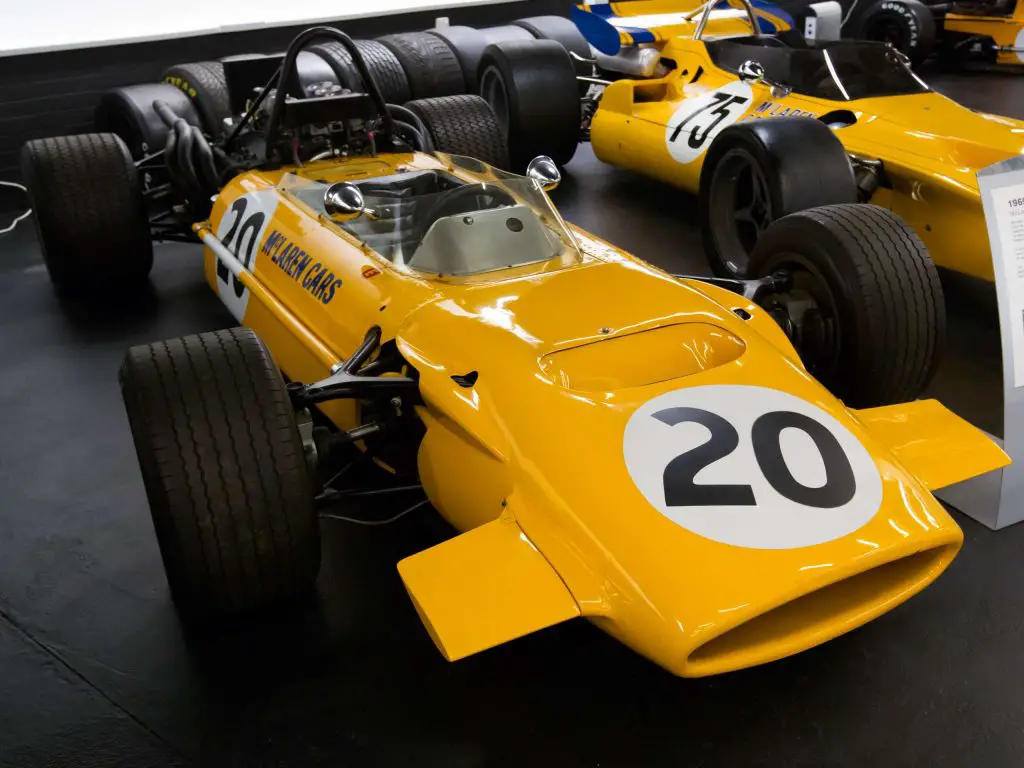Last Updated on September 23, 2023 by Pittalks
The purpose of all-wheel drive (AWD) is to give the vehicle more traction. The reason for this extra traction is that AWD splits up the power among all four wheels instead of just two. This will allow for better grip and increased safety.
However, AWD is not used for F1 cars because of many reasons. The 2 main reasons are:
- The Fédération Internationale de l’Automobile (FIA) does not allow more than 2 wheel drive
- The AWD system is not good for F1 cars’ performance
In fact, all F1 cars use rear-wheel drive (RWD) as it is the most efficient way (in terms of fuel consumption and car performance) to transfer power to the wheels. This article will break down the details and help you understand why AWD is not used for F1 cars nowadays.
Let’s get started!
Reason 1: FIA has banned AWD
In the past, a few F1 cars used AWD. Ferguson P99 is the very first one and that’s also the only AWD car to ever win an F1 race.
Another fun fact, the last front-engined vehicle to win an F1 race was the Ferguson P99.
In 1982, FIA banned anything that had more than 2 wheel drive. This law is still in effect today. But why did they ban it?
Patrick Head, co-founder and former Engineering Director of the Williams F1 team, said: “After someone in a FOCA meeting said it would drive up costs and cause chaos during pit stops. The regulations were changed to say a car could only have four wheels, of which only two could be driven.”
Read next: How Much Horsepower Does an F1 Car Have?
Reason 2: AWD system is too heavy and more likely to fail
It is a common fact that F1 cars are overloaded with all the different components in order to make them go faster. On the other hand, adding more weight means more power is needed to spin the wheels.
With that in mind, the AWD system is too heavy (hundreds of extra pounds) compared to other systems that are lighter and more efficient, such as the FWD or RWD. But yes, AWD does offer better grip, which means faster speed at corners and starts.
However, F1 cars are well-known for insane downforce due to their aerodynamic design. And the extra grip offered by AWD is insignificant when you compare those two aspects.
So, practically speaking, AWD does not really offer that much of a benefit in terms of speed or grip, but it does add more unnecessary weight to the car. Even if AWD weighed 0 pounds, it would be difficult to detect any advantage this system provides.
This is because the AWD system is more likely to fail in the harsh environment of F1 races as it’s a much more complicated design.
Read next: What is DRS in F1?
Reason 3: AWD requires 4 wheels to be uniform, but F1 rear tires are wider than front tires
AWD requires 4 wheels to be exactly the same size. Since AWD splits the power between 4 wheels, all of them should have equal grip during a race.
If your car is AWD and the tires are not the same, they wear out faster, which will reduce the grip, making the car slower.
Unfortunately, F1 cars’ front tires are thinner than rear tires (even though they have the same diameter.)
F1 cars are RWD, so the rear tires need more grip (wider tires have a larger contact surface with the road.) The front tires are smaller so that the car can have less weight, less aerodynamic drag, and better steering.
These 2 factors conflict with each other, making F1 cars with AWD system even more unrealistic.
Keep reading: Why Don’t F1 Cars Have A Clutch Pedal?
List of F1 cars with AWD
In the past, there were some F1 cars that did use the AWD system. Let’s take a quick look at them!
Ferguson P99 (1961)

The Ferguson P99 was the first four-wheel-drive Formula 1 car. “Project 99” had been under development since 1950, with the contribution of Harry Ferguson, Claude Hill, Fred Dixon, and Tony Rolt.
This car won the Formula 1 Oulton Park Gold Cup in 1961 with a 4-cylinder 1.5L engine.
BRM P67 (1964)

The BRM P67 was the second 4WD F1 car to be made. Unfortunately, due to its poor performance, the project was abandoned. Read more about the P67 here.
Lotus 63

The Lotus 63 4WD was another failed attempt from the Lotus team.
After a test run, Graham Hill refused to drive the 63 car any longer, saying it was a “deathtrap.”
Matra MS84

In Matra MS82’s first race, Jean-Pierre Beltoise drove the car to finish 8th. He was 6 laps behind Stewart’s two-wheel drive car (but 3 laps ahead of the Lotus 63.)
McLaren M9A

This car could only race once at British Grand Prix 1969, and then it was abandoned. The 4WD transmission was developed by McLaren, but it was largely based on the Ferguson design.
Cosworth

Designed by Robin Herd, the Cosworth F1 car had a different 4WD transmission from the Ferguson used by all other 4WD F1 cars of the 1960s.
The vehicle was prepared to compete in the 1969 British Grand Prix, but then it was withdrawn. The main reason for this is the excessive understeer that comes as a result of the heavy front.
Jackie Stewart, who gave this car a few testing laps, described it as: “It’s so heavy on the front, you turn into a corner, and the whole thing starts driving you. The car tries to take you over.”
Lotus 56B (1971)

Another 4WD design by the Lotus team, The Lotus 56B joined 3 Grands Prix and 3 non-championship events in 1971. In wet weather, its advantage over the two-wheel-drive cars was significant. Throughout dry races, 56B was relegated to a mid-field runner because of its hefty weight.
More history: NASCAR vs F1
Conclusion
In the 60s, many F1 teams tried out AWD transmissions for their cars. The end result was pretty much always the same – understeer, extra weight, and lack of speed.
In the end, most teams abandoned their AWD projects and got back to the RWD system. And eventually, the FIA banned AWD completely in 1982.
Will there be any AWD F1 cars in the future?
With all the reasons I gave you above, then NO, there won’t be!
And that’s it for the article! Leave a comment below if you have any thoughts.
You may also like: Are F1 cars manual? If so, how many gears do they have?
References:
- https://www.auto123.com/en/news/f1-patrick-heads-technical-focus-on-the-6-wheel-williams-f1-car/8819/
- https://www.ferguson-museum.co.uk/racing_car.htm
- https://www.oldracingcars.com/mclaren/m9a/
- https://www.f1technical.net/f1db/cars/271/lotus-56b
- https://f1.fandom.com/wiki/Lotus_56
- https://en.wikipedia.org/wiki/BRM_P67
- http://www.formula1-dictionary.net/engine_cosworth_story.html
Related articles
-

F1 pit stops 101 | All rules simply explained
Did you know that the average F1 pit stop takes just under three seconds?
In that time, 4 tires are changed, and any necessary adjustments are made. In a sport where fractions of a second can make….Read more

Why don’t F1 cars have clutch pedal? But they do have a clutch!
Since its invention in the early 19th century, the clutch has been a key component of all motor vehicles. But do race cars like those in Formula One (F1) still need them?

